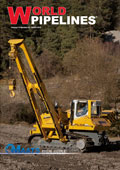Editorial comment
North Slope producers recently presented a joint pitch to Alaska Governor Sean Parnell outlining plans for the newest re-draft of their Alaska Pipeline Project: a large-diameter gas pipeline and LNG export facility.
Register for free »
Get started now for absolutely FREE, no credit card required.
BP, ExxonMobil, ConocoPhilips and TransCanada Alaska wrote together to Parnell with commitments for the 800 mile pipeline and LNG plant, which is to be built in an as-yet-undecided location at the south end of the pipe. Costing in the region of US$ 45 - 60 billion, the 42 in. pipeline will transport 3 - 3.5 billion ft3/d of gas to the LNG plant, which will be built in a southern Alaskan port city (probably either Valdez or Nikiski). Designed to monetise North Slope gas by exporting it as LNG to Asia (particularly South Korea and Japan), the pipeline will also meet Alaskans’ needs for energy. Communities along the ROW will be able to take 250 - 500 million ft3/d for local use. As Gov. Parnell explained in his fourth state-of-the-state address in January, the large diameter pipeline provides “a simple answer to a complex question about how to lower the cost of getting Alaska’s gas to Alaskans: get more gas in the pipe.” Further on down the line, a large-scale LNG plant is planned, with three trains capable of producing 15 - 18 million tpy of LNG for export.
The letter from the producers indicates that some form of regulatory help is needed in order to expedite the project. The state is currently working on a bill that would restructure and reduce state oil taxes, and Gov. Parnell has promised to turn his attention to natural gas tax reform next year.
This big pitch, a considered and consummate approach by a consortium of producers, is a decisive move in getting a North Slope gas pipeline built. The proposed project meets two objectives as it feeds local and global demand with a viable and flexible plan.
On the subject of viability, in this issue we include a report on pipeline reversals (‘Reversal of fortune’, p. 64). Gordon Cope writes about the new trend for reversing pipeline flow in cases where supply and demand have shifted. Pipeline reversals are about getting the most out of the new normal: in the midst of new global energy dynamics (a gas glut here, new crude sources there, oilsands production ramping up) we make an existing pipeline asset more viable by, literally, changing directions.
In this we see a willingness to move away from traditional thinking about what ‘always used to work’ and towards a new approach of ‘what works now’. Now, more than ever, we must produce pipeline solutions that are both custom-made to the particular supply and demand situation in hand, and yet flexible so that future changes might be accommodated; we have to be ready to adapt. We all face transition situations where what we tried before no longer works, whether this is at home, in the office, or with our children or our dogs – if you can name it, things can change with it. The status quo sometimes has to status GO! For some interesting thoughts on this see Martha Beck on ‘culture versus compass’, or Danielle LaPorte on ‘ruthless compassion’, or Roger Martin on ‘the design of business’.
I have recently celebrated eight years with World Pipelines and when I look back at Comment pages past I see I used to write a lot about Alaska. The big Alaska pipeline project was always focused on the lower 48 states model, whether it was the Alaska Pipeline project or the ill-fated Denali proposal, or other iterations of the project. Now this has changed. I’m still writing about Alaska but eyes are firmly on the rising opportunities in Asia. The decades-old plan to bring North Slope gas to market is newly and neatly repackaged in a shiny project that encompasses a large diameter solid, stable pipeline asset and a large-scale, flexible-by-nature, LNG facility.


